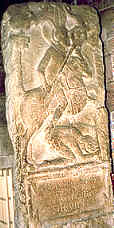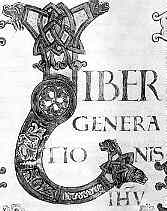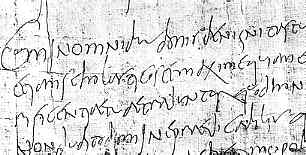|
|
|
|
|
|
|
 |
|
Roman
Scripts |
|
The
Roman alphabet was ultimately derived from that of the Greeks through
the mediation of the Etruscans. Within the Classical Roman period scripts
continued to evolve. There is a broad division between Old
Roman scripts and New
Roman scripts, although the former did not actually disappear, but
were used for different purposes. This change did not occur abruptly,
but the New Roman scripts had evolved by the 4th century. |
|
The
various forms of these scripts were the basis for the development of all
the scripts of the middle ages. The Latin alphabet was basically the same
as that in use today, but lacked the letters J,
V and W. I and U were both used as consonants as well
as vowels. K, Y and Z all existed but were rare letters.
This usage of the alphabet continued in medieval Latin. |
|
The
most formal of the Old Roman scripts was square
capitals or capitalis
quadrata, used mainly for carved inscriptions where it is also known
as scriptura
monumentalis. It was an angular majuscule
script, often written without breaks between words or with words separated
by dots. |
 |
Inscription
in square capitals on a Roman altar in the museum at Chesters Fort on
Hadrian's Wall. |
|
Carved
Roman tombstones like this one in Hexham Abbey church, Northumberland,
bore inscriptions in square capitals. |
| It
has only rarely been found in manuscripts,
sometimes in the early medieval period as a display script for headings.
Some early Spanish manuscripts were evidently written in square capitals. It has occasionally been found in very early manuscripts of the highest cultural value. |
 |
Square
capitals used in a manuscript of Virgil's Aeneid from the Library
of St Gall (Cod.1394,p.12). |
| The works of Virgil were some of the highest valued of the early medieval or post-Roman period. The manuscript leaves of the example above were found doing duty
as book covers. |
|
|
|
|
|
|
|
|
Square
capitals used as part of a decorative heading in an 11th century gospel
book (Cambridge, Trinity College Library, MS.B.10.4). |
|
| Looking ahead for a moment, the introduction of Caroline mimuscule as a formal book hand from around the 8th century onwards went along with the revival of a hierarchy of older majuscule scripts for headings, of which square capitals was the most formal. |
|
More
commonly used in early manuscripts as a book
hand was rustic
capitals, a majuscule script with rather more rounded letter forms
that were easier to produce with a pen than the angular forms of square
capitals. This script from the Old Roman period continued into use into
the medieval era, mainly for display headings, although occasionally appearing in the early period for full texts. The term capitalis
designates generally these Old Roman and later majuscule scripts. |
|
|
Rustic
capitals used in a page of text in an Anglo-Saxon manuscript, the 8th
century Vespasian Psalter (British Library, Cotton Vespasian A1, f.6),
by permission of the British Library.
|
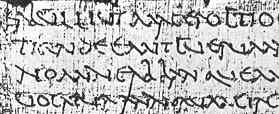 |
In
the 1st century AD, the script used for business, administration and for
private letters was Old
Roman cursive. This was a majuscule script, despite its cursive
qualities, and is therefore sometimes known as cursive
capitals. At this time papyrus
was the usual writing material and the usual form of manuscripts was as
a roll. |
|
An
example of Old Roman cursive from a purchase agreement of AD 166 on papyrus
(British Library Papyrus CCXXIX). |
| Somewhat
more formal variants of Old Roman cursive are in existence for literary
works. These hybrid forms have sometimes been designated as literary
cursive. |
|
Between
the 2nd and the early 4th centuries there was a continuing change to both
formal and cursive scripts. There was, at the same time, a change from
the use of papyrus to parchment,
and from the roll to the codex
for literary works.
This had an enormous effect on the corpus of Classical works which were to survive through the middle ages, but that is another part of the story. |
|
The
formal book hand of the late Roman period and beyond until the 7th century
was uncial. This
majuscule script had particularly rounded forms and may have been influenced
by Greek book scripts, as well as incorporating cursive forms of several
letters. The Bibles,
psalters and other
religious books of the missionary monks, who reintroduced Christianity
across Europe as far as Britain, were written in uncial script. It was
used as a display script for headings up until the 12th century. |
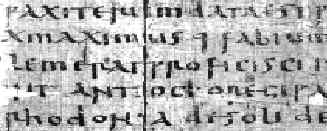 |
Sample from
a 3rd or 4th century copy of the Epitome of Livy on papyrus (British Library
Papyrus 1532(1)), by permission of the British Library. |
| The above is a very early example of uncial, mixed in with some minuscule forms, written on papyrus and recovered from Egypt. It looks a trifle untidy compared to the very formal varieties in use in the early medieval period, as shown below. |
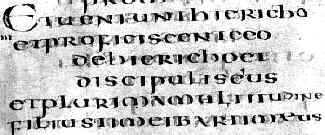 |
Uncial
script in a 6th century Italian Gospel (British Library, Harley 1775,
f.195), by permission of the British Library. |
|
Half
uncial developed as a book hand over the same period, although uncial
was favoured for more formal works until the 7th century. It is a minuscule
script with most letters derived from cursive forms, but it had evolved
into a rounded and formal book hand. Despite the name, it was not derived
from uncial. It was in use until around the 8th century. |
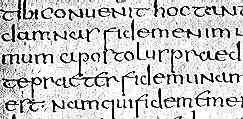 |
Half
uncial script of the early 6th century manuscript of St Hilarius of Poiteirs on the
Trinity in the Archives of St Peter in Rome. |
|
Cursive
writing, used for business and administrative purposes and for personal
handwriting, also evolved into a minuscule form. This is known as New
Roman cursive.
It is alleged that there are scholars around who can read it. |
|
New
Roman cursive from a 5th century letter on papyrus, found in Egypt (Strassburg,
Pap. lat. Argent.1). |
|
|
|
|
There
were hybridised forms of these scripts within the Roman period, sometimes
designated with names such as cursive
half uncial or quarter
uncial. This process of evolution and hybridisation with cursive forms
resulted in the development of a diversity of minuscule scripts in the
7th and 8th centuries. |
|
Post-Roman
scripts |
 History
of Scripts History
of Scripts |
 What
is Paleography? What
is Paleography? |
|
 |
 |
 |
 |
 |
 |
 |

